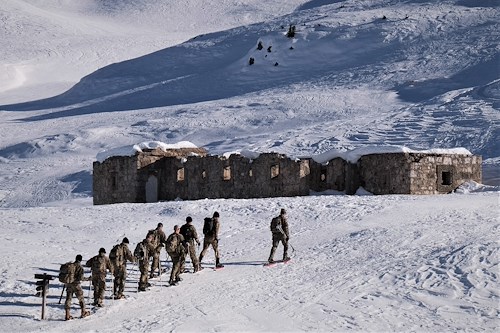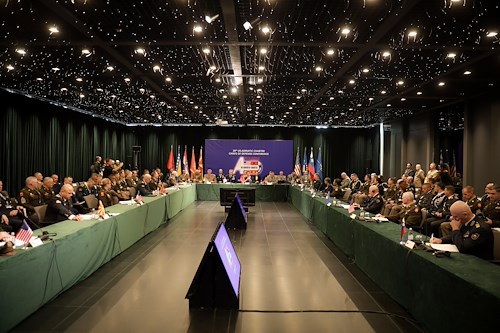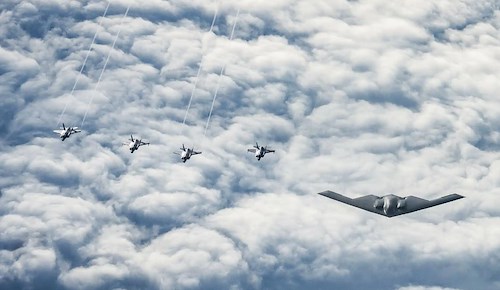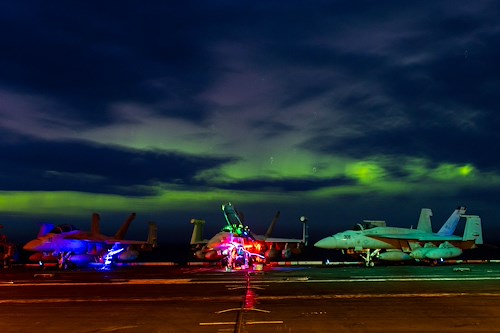Gallery contains 9 images
×
Photo 1 of 9
2500th DLD Soldiers summit Monte Specie during training with Italy´s 6th Alpine Regiment
U.S. Army Reserve Soldiers from the 2500th Digital Liaison Detachment, 7th Mission Support Command, use snowshoes to summit Monte Specie while conducting search, rescue and recovery training with three alpine instructors from the Italian Army´s 6th Alpine Regiment during exercise Alpine Rock in Toblach, Italy, January 10-12, 2020. Fifteen Soldiers from the 2500th participated in the winter survival training that emphasized small-unit tactical interoperability.
Photo by: Sgt. Daniel Friedberg
Photo 2 of 9
2500th DLD Soldiers summit Monte Specie during training with Italy´s 6th Alpine Regiment
U.S. Army Reserve Soldiers from the 2500th Digital Liaison Detachment, 7th Mission Support Command, use snowshoes to summit Monte Specie while conducting search, rescue and recovery training with three alpine instructors from the Italian Army´s 6th Alpine Regiment during exercise Alpine Rock in Toblach, Italy, January 10-12, 2020. Fifteen Soldiers from the 2500th participated in the winter survival training that emphasized small-unit tactical interoperability.
Photo by: Sgt. Daniel Friedberg
Photo 3 of 9
2500th DLD Soldiers summit Monte Specie during training with Italy´s 6th Alpine Regiment
U.S. Army Reserve Soldiers from the 2500th Digital Liaison Detachment, 7th Mission Support Command, stand at the peak of Monte Specie while conducting search, rescue and recovery training with three alpine instructors from the Italian Army´s 6th Alpine Regiment during exercise Alpine Rock in Toblach, Italy, January 10-12, 2020. Fifteen Soldiers from the 2500th participated in the winter survival training that emphasized small-unit tactical interoperability.
Photo by: Sgt. Daniel Friedberg
Photo 4 of 9
2500th DLD Soldiers summit Monte Specie during training with Italy´s 6th Alpine Regiment
U.S. Army Reserve Soldiers from the 2500th Digital Liaison Detachment, 7th Mission Support Command, pose for a photo at the peak of Monte Specie while conducting search, rescue and recovery training with three alpine instructors from the Italian Army´s 6th Alpine Regiment during exercise Alpine Rock in Toblach, Italy, January 10-12, 2020. Fifteen Soldiers from the 2500th participated in the winter survival training that emphasized small-unit tactical interoperability.
Photo by: Sgt. Daniel Friedberg
Photo 5 of 9
2500th DLD Soldiers summit Monte Specie during training with Italy´s 6th Alpine Regiment
Italian Army Luogotenente Ewald Beikircher, commander of the Ski and Climbing Platoon, 79th Company, 6th Alpine Regiment, points out the former border between Austria and Italy while leading U.S. Army Reserve Soldiers from the 2500th Digital Liaison Detachment, 7th Mission Support Command, on a summit of Monte Specie during search, rescue and recovery training in Toblach, Italy, January 10-12, 2020. Fifteen Soldiers from the 2500th participated in the winter survival training that emphasized small-unit tactical interoperability.
Photo by: Sgt. Daniel Friedberg
Photo 6 of 9
2500th DLD Soldiers summit Monte Specie during training with Italy´s 6th Alpine Regiment
U.S. Army Reserve Col. Gregory E. Gimenez (right), commander of the 2500th Digital Liaison Detachment, 7th Mission Support Command, presents a unit friendship plaque (from left) to Tenente Colonello Stefano Bertinotti, commander of the Italian Army´s 6th Alpine Regiment, Caporal Maggiore Capo Thomas De Toni, Caporal Maggiore Capo Matteo Lovat, and Luogotenente Ewald Beikircher, of the Ski and Climbing Platoon, 79th Company, 6th Alpine Regiment, in appreciation after the conclusion of exercise Alpine Rock in Toblach, Italy, January 12, 2020. Fifteen Soldiers from the 2500th participated in the winter survival training that emphasized small-unit tactical interoperability.
Photo by: Sgt. Daniel Friedberg
Photo 7 of 9
2500th DLD Soldiers summit Monte Specie during training with Italy´s 6th Alpine Regiment
U.S. Army Reserve Sgt. Lara R. Dasilva, a supply sergeant with the 2500th Digital Liaison Detachment, 7th Mission Support Command, and Caporal Maggiore Capo Thomas De Toni, an Italian Army instructor with the Ski and Climbing Platoon, 79th Company, 6th Alpine Regiment, use a Pieps avalanche beacon to locate a notional avalanche victim for winter survival training during exercise Alpine Rock in Toblach, Italy, January 11, 2020. Fifteen Soldiers from the 2500th participated in the winter survival training that emphasized small-unit tactical interoperability.
Photo by: Sgt. Daniel Friedberg
Photo 8 of 9
2500th DLD Soldiers summit Monte Specie during training with Italy´s 6th Alpine Regiment
U.S. Army Reserve Master Sgt. Carlos Garcia, 2500th Digital Liaison Detachment, 7th Mission Support Command, pins rank on Staff Sgt. Wesley Cyrus, 2500th DLD, 7th MSC, in a mountain-top promotion ceremony after his unit used snowshoes to summit Monte Specie during winter survival training with the Italian Army´s 6th Alpine Regiment during exercise Alpine Rock in Toblach, Italy, January 11, 2020. Fifteen Soldiers from the 2500th participated in the winter survival training that emphasized small-unit tactical interoperability.
Photo by: Sgt. Daniel Friedberg
Photo 9 of 9
2500th DLD Soldiers summit Monte Specie during training with Italy´s 6th Alpine Regiment
U.S. Army Reserve Lt. Col. Cory D. Poppe, 2500th Digital Liaison Detachment, 7th Mission Support Command, pins rank on Sgt. 1st Class Mark Jacobson, 2500th DLD, 7th MSC, in a mountain-top promotion ceremony after his unit used snowshoes to summit Monte Specie during winter survival training with the Italian Army´s 6th Alpine Regiment during exercise Alpine Rock in Toblach, Italy, January 11, 2020. Fifteen Soldiers from the 2500th participated in the winter survival training that emphasized small-unit tactical interoperability.
Photo by: Sgt. Daniel Friedberg
U.S. Army Reserve Soldiers from the 2500th Digital Liaison Detachment, 7th Mission Support Command, used snowshoes to summit Monte Specie while conducting search, rescue and recovery training with three alpine instructors from the Italian Army´s 6th Alpine Regiment (6th Regimento Alpini), here, Jan. 10-12, 2020.
The compact survival course emphasized winter survival and small-unit tactical interoperability.
“This was a challenging activity, a very rigorous activity and it included every level of the unit,” said U.S. Army Reserve Capt. Michael Benjamin, operations officer for the 2500th. “It was another outstanding training experience.”
The 2500 DLD has conducted cold weather training with the 6th Alpine Regiment for more than five years and it has provided a platform for partnership and team building within the unit and with its Italian partners, Benjamin added.
The 2500th mainly functions to connect coalition divisions and corps with U.S. maneuver forces utilizing the full suite of mission command systems across the spectrums of field artillery, air defense, operations, logistics and intelligence.
“The planning and execution phase of the event allowed the U.S. Army Reserve and Italian Army partnership relationship to strengthen and build an understanding of capabilities, communication, and culture,” said Benjamin. “Because of joint training events like these, NATO partners will have a clearer understanding towards interoperability.”
Italian Army Luogotenente Ewald Beikircher, commander of the Ski and Climbing Platoon, 79th Company, 6th Alpine Regiment, kicked off the training on Friday evening with a physics lesson on snow for the 15 Soldiers of the 2500th who made the trip from their home base in Vicenza, Italy.
He concluded the classroom training by teaching avalanche risk mitigation in support of tactical military operations at high altitude.
The Soldiers were then fitted with snowshoes, avalanche locator equipment and entrenching tools in preparation for the next two days of outdoor training.
On Saturday morning, Beikircher, along with Caporal Maggiore Capo Thomas De Toni and Caporal Maggiore Capo Matteo Lovat, also with the Ski and Climbing Platoon, 79th Company, 6th Alpine Regiment, checked that all climbers’ personal avalanche beacons were functioning properly and led the Troops in snowshoes across the Prato Piazzo plain on the ascent to the mountain.
Beikircher, an experienced special operations Paratrooper, used rest breaks during the hike to conduct short training sessions and to point out areas on the mountain that were high-risk for an avalanche.
“As I told you yesterday, 50% of the avalanche victims die of injury, broken bones and punctured lungs and not suffocation,” said Beikircher, emphasizing that avalanche avoidance, and not rescue, was key to survival.
After 90 minutes of continuous climbing up the slope in stark sunlight and a cloudless blue sky, the Soldiers of the 2500th DLD arrived at a wooden cross marking the peak of Monte Specie at more than 7,545 feet.
At the top, they caught their breath and then formed up for a promotion ceremony to pin new rank on two of their own.
Beikircher explained that Monte Specie continues to be deeply historic for the South Tyrolean region as it was a highly contested battle site for more than three years between Italy and Austria-Hungary during World War I.
“This Cime (mountain ridge) used to be the border between Austria and Italy,” said Beikircher pointing towards the jagged Dolomite mountain peaks visible to the south.
He explained that during the war mountain units such as the 6th Alpine Regiment needed to develop, under combat, the same skills the Soldiers of the 2500th DLD were training to learn.
Beikircher then led the Soldiers on a descent of the peak towards the Refugio Vallandro (the hikers lodge at the bottom) stopping occasionally to explain how weather and snow measurement stations along the path give information and data to predict avalanche danger and reduce mortality.
He also explained that skilled, socially-active volunteers today work on many local ski patrols and fire departments in the region much like the Citizen-Soldiers who also serve in the U.S. Army Reserve, balancing active civilian careers and responsibilities.
Descent complete, the U.S. and Italian Soldiers enjoyed a meal together at the Refugio Vallandro restaurant before beginning their survival snow training.
The instructors concluded Saturday´s training by building a snow bivouac using only snow, ski poles and light fabric. They showed, that with proper construction, the shelter could provide comfortable warmth even in sub-zero temperatures.
“It was really rough training but we really got up to speed about what was out there and what to watch out for,” said Spc. Benito Kayenge, a medic with the 2500th DLD.
“I actually went in there and I think it was pretty fun,” said Kayenge of the snow bivouac.
On Sunday after breakfast, the Soldiers rode the cable cars up the ski slopes near the barracks at San Candido for the last bit of winter survival training in avalanche rescue techniques before being greeted by the commander of the 6th Alpine Regiment, Tenente Colonello Stefano Bertinotti.
U.S. Army Reserve Col. Gregory E. Gimenez, commander of the 2500th DLD, presented Bertinotti, Beikircher, De Toni and Lovat a memorial plaque to thank the Italian Soldiers for their hospitality, instruction and knowledge.
Bertinotti presented the 6th Alpine Regiment eagle plaque to Gimenez along with a Panettone cake; a traditional gift in Italy during the holiday seasons.
“Training with an allied partner during peacetime, will lay the stage for execution during wartime operations,” said Benjamin. “That is what this event is all about - strong partnerships. Everyone departed San Candido feeling a sense of pride in themselves, the unit, and NATO partnerships.”































